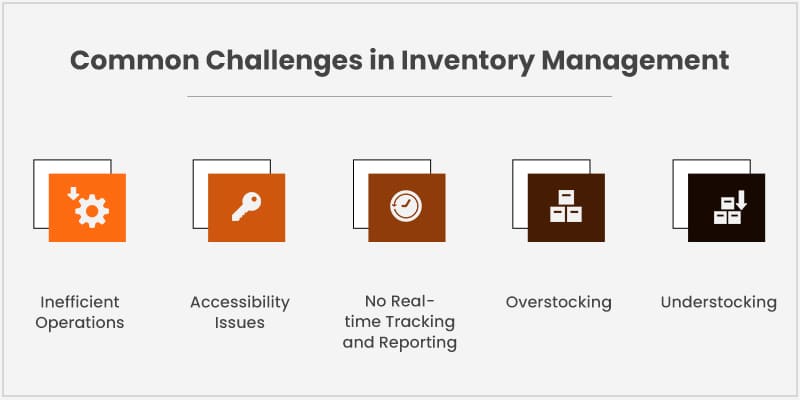
Navigating the Labyrinth: A Comprehensive Look at Business Inventory Management Challenges
Abstract:
Inventory management is a critical function within any business, acting as the bridge between supply and demand. Effective management ensures operational efficiency, customer satisfaction, and financial health. However, businesses frequently encounter a myriad of complex challenges in this domain, ranging from accurate demand forecasting and cost optimization to supply chain disruptions and technological integration. This article delves into the primary difficulties faced by businesses in managing their inventory, exploring the multifaceted nature of these challenges and their far-reaching implications. By understanding these obstacles, businesses can better strategize and implement robust solutions to transform inventory management from a potential liability into a significant competitive advantage.
Introduction: The Crucial Role of Inventory Management
Inventory, often referred to as the lifeblood of a business, represents a significant investment and a vital operational asset. From raw materials and work-in-progress to finished goods and spare parts, efficient management of these items is paramount for sustaining operations, meeting customer demands, and maintaining profitability. Businesses strive to strike a delicate balance: having enough stock to prevent disruptions and satisfy customers, but not so much that it incurs excessive holding costs or risks obsolescence.
However, achieving this equilibrium is far from straightforward. The modern business landscape is characterized by volatility, uncertainty, complexity, and ambiguity (VUCA), which intensifies the inherent challenges of inventory management. Businesses, regardless of their size or industry, frequently grapple with a range of issues that can erode profit margins, damage customer relationships, and impede growth. This article aims to explore these critical challenges in detail, providing a comprehensive overview of the hurdles businesses must overcome to master their inventory.
1. Inaccurate Demand Forecasting
At the heart of almost every inventory management challenge lies the difficulty of accurately predicting future demand. Demand forecasting is an inherently complex task influenced by a multitude of factors, making it one of the most significant pain points for businesses.
- Market Volatility: Rapid changes in consumer preferences, economic conditions, and competitive landscapes can render even sophisticated forecasting models obsolete.
- Seasonality and Trends: Products often exhibit seasonal demand patterns or follow short-lived trends, requiring dynamic adjustments that are hard to predict with precision.
- Promotional Activities: The impact of marketing campaigns, discounts, and special offers on demand can be difficult to quantify and integrate into forecasts.
- External Factors: Unforeseen events such as pandemics, natural disasters, geopolitical tensions, or sudden regulatory changes can drastically alter demand patterns, making historical data less reliable.
- New Product Introductions: Forecasting demand for entirely new products with no historical sales data is exceptionally challenging, often relying on market research and analogous product performance, which carry inherent risks.
The consequences of inaccurate forecasting are severe:
- Overstocking: Leads to excess inventory, tying up capital and increasing holding costs.
- Understocking/Stockouts: Results in lost sales, customer dissatisfaction, and potential damage to brand reputation.
2. Overstocking and Obsolescence
While stockouts are immediately painful, overstocking presents a more insidious threat, quietly eroding profitability over time.
- High Holding Costs: Maintaining excess inventory incurs significant expenses, including:
- Storage Costs: Rent, utilities, insurance, security, and maintenance of warehouse space.
- Capital Costs: The opportunity cost of capital tied up in inventory that could otherwise be invested elsewhere.
- Risk Costs: Insurance against theft, damage, or loss, as well as the cost of potential write-offs.
- Labor Costs: For handling, tracking, and managing larger quantities of stock.
- Obsolescence: This is particularly critical for industries dealing with perishable goods (food, pharmaceuticals), fast-fashion items, or rapidly evolving technology. Inventory can become obsolete due to:
- Expiration Dates: Products becoming unsellable after a certain period.
- Technological Advancements: Newer, better products making existing stock outdated.
- Changing Trends/Fashions: Items falling out of style, making them difficult to sell at full price.
- Damage or Spoilage: Physical deterioration over time, especially with prolonged storage.
Obsolescence not only results in direct financial losses from write-downs but also creates warehouse congestion, hindering efficient operations and potentially leading to further damage or misplacement of other goods.
3. Understocking and Stockouts
On the flip side of overstocking is the equally detrimental problem of understocking, leading to stockouts.
- Lost Sales and Revenue: When a customer wants to purchase an item that is out of stock, the sale is immediately lost, and the customer may turn to a competitor.
- Customer Dissatisfaction and Loyalty Erosion: Repeated stockouts can frustrate customers, leading to a negative perception of the brand and a switch to competitors, impacting long-term customer loyalty.
- Production Delays: For manufacturers, a shortage of raw materials or components can bring production lines to a halt, incurring significant downtime costs and delaying finished product delivery.
- Expedited Shipping Costs: To mitigate stockouts, businesses often resort to costly rush orders and expedited shipping, eating into profit margins.
- Reputational Damage: Consistent inability to fulfill orders can damage a company’s reputation, making it harder to attract new customers and retain existing ones.
4. Data Inaccuracy and Lack of Visibility
Effective inventory management hinges on accurate, real-time data. Unfortunately, many businesses struggle with data integrity and a lack of comprehensive visibility across their inventory holdings.
- Manual Processes and Human Error: Reliance on manual counting, data entry, and spreadsheet-based tracking is prone to human error, leading to discrepancies between physical inventory and system records.
- Disparate Systems: Many companies use multiple, unintegrated systems (e.g., separate systems for purchasing, warehousing, sales) that do not communicate effectively, creating data silos and an incomplete picture of inventory.
- Theft and Damage: Shrinkage due to theft, damage, or misplacement further contributes to data inaccuracy, making it difficult to reconcile inventory records.
- Lack of Real-time Updates: Without systems that provide real-time updates on stock levels, businesses operate on outdated information, leading to poor decision-making regarding ordering, fulfillment, and sales.
- Complex SKUs and Locations: Businesses with a vast number of Stock Keeping Units (SKUs) or multiple warehouse locations find it incredibly challenging to maintain accurate records across all items and sites.
Poor data accuracy leads to incorrect forecasting, inefficient order placement, and an overall inability to optimize inventory levels.
5. Supply Chain Disruptions
The globalized nature of modern supply chains introduces significant vulnerability, making inventory management susceptible to external shocks.
- Supplier Reliability: Delays or quality issues from suppliers can disrupt the flow of goods, leading to stockouts or production halts.
- Transportation Issues: Port congestions, shipping delays, labor shortages in logistics, or rising fuel costs can severely impact lead times and delivery schedules.
- Geopolitical Events: Trade wars, sanctions, or regional conflicts can disrupt sourcing channels and increase costs.
- Natural Disasters and Pandemics: Events like earthquakes, floods, or global health crises can shut down manufacturing facilities, disrupt transportation networks, and create widespread shortages, as vividly demonstrated by the COVID-19 pandemic.
These disruptions introduce unpredictability into lead times, making it challenging to maintain optimal safety stock levels without incurring excessive costs.
6. Cost Management Complexity
Inventory management is a constant balancing act of various costs, and optimizing this balance is a complex challenge.
- Holding Costs vs. Ordering Costs: Businesses must weigh the costs of holding inventory (storage, capital, obsolescence) against the costs of placing frequent, smaller orders (administrative costs, shipping fees, potential volume discounts missed).
- Shortage Costs: The implicit costs of stockouts, including lost sales, customer dissatisfaction, and expedited shipping, are often difficult to quantify but can be substantial.
- Hidden Costs: Beyond the obvious, there are hidden costs associated with inventory, such as administrative overhead for managing returns, quality control issues, and the depreciation of handling equipment.
- Optimization Models: Implementing and maintaining sophisticated inventory optimization models (e.g., Economic Order Quantity, Reorder Point) requires expertise and reliable data, which are often lacking.
Finding the sweet spot that minimizes total inventory costs while maintaining desired service levels requires continuous analysis and adjustment.
7. Technology Adoption and Integration
While technology offers powerful solutions for inventory management, its adoption and effective integration present their own set of challenges.
- High Initial Investment: Implementing advanced Inventory Management Systems (IMS), Warehouse Management Systems (WMS), or Enterprise Resource Planning (ERP) solutions can require significant upfront capital, which might be prohibitive for smaller businesses.
- Complexity of Integration: Integrating new systems with existing legacy software, hardware (e.g., RFID, barcode scanners), and third-party logistics providers can be technically complex, time-consuming, and prone to issues.
- Resistance to Change: Employees may resist new technologies due to a lack of familiarity, fear of job displacement, or reluctance to abandon established (though inefficient) processes.
- Lack of Technical Expertise: Businesses may lack the internal IT staff or expertise required to implement, maintain, and fully leverage sophisticated inventory management software.
- Choosing the Right Solution: The market offers a vast array of solutions, and selecting the one that best fits a business’s specific needs, scale, and budget can be a daunting task.
Without proper technology, businesses remain stuck with inefficient manual processes, limited visibility, and an inability to scale.
8. The Human Factor and Training
Even with the best systems, human involvement remains critical, and the human element can introduce its own set of challenges.
- Lack of Training: Inadequate training for staff on inventory procedures, system usage, and best practices can lead to errors, inefficiencies, and improper handling of goods.
- Accountability and Ownership: A lack of clear roles, responsibilities, and accountability for inventory management can result in negligence, misplacements, and unchecked discrepancies.
- High Turnover: In warehouse or logistics roles, high employee turnover can lead to a perpetual state of training new staff, making it difficult to build consistent expertise and maintain process adherence.
- Fraud and Theft: Internal theft, while hopefully rare, can contribute to inventory shrinkage and data inaccuracies if not properly monitored and controlled.
Investing in comprehensive training and fostering a culture of accountability are essential to overcoming these human-related challenges.
Conclusion: Embracing a Strategic Approach
Inventory management is not merely a logistical task; it is a strategic imperative that directly impacts a business’s financial performance, operational efficiency, and customer relationships. The challenges discussed – from inaccurate demand forecasting and the dual threats of overstocking and understocking, to data inaccuracies, supply chain disruptions, and the complexities of cost and technology management – underscore the intricate nature of this function.
Overcoming these hurdles requires a multi-faceted approach:
- Embracing Technology: Investing in robust inventory management systems, ERPs, and data analytics tools to improve forecasting accuracy, real-time visibility, and process automation.
- Data-Driven Decision Making: Cultivating a culture that prioritizes accurate data collection, analysis, and continuous improvement in forecasting models.
- Supply Chain Resilience: Building agile and resilient supply chains through diversification of suppliers, strategic safety stock planning, and scenario planning for potential disruptions.
- Continuous Optimization: Regularly reviewing and optimizing inventory policies, balancing holding costs with ordering and shortage costs.
- Investing in People: Providing comprehensive training, fostering accountability, and leveraging employee insights to improve operational efficiency.
By proactively addressing these challenges, businesses can transform their inventory management from a source of frustration and cost into a powerful engine for growth, customer satisfaction, and sustained competitive advantage in an ever-evolving market. The labyrinth of inventory management may be complex, but with strategic planning and diligent execution, businesses can navigate it successfully.

